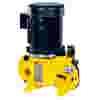What is a double diaphragm pump and rupture detection in detail?
A double diaphragm pump consists of two flexible diaphragms that moves back and forth, drawing fluid into the pumps and pushing it out. Rupture detection system in a double diaphragm pump monitors the condition of the pump's diaphragm to prevent cross-contamination of the process fluid and the pump's hydraulic system. In most cases, the redundant diaphragm is a diaphragm in contact with the process fluid.
How is a ruptured diaphragm detected in a double diaphragm pump?
During normal operation, the pressure between the two diaphragms is much lower than the process pressure. If either diaphragm fails, the system senses the process pressure from either fluid while the redundant diaphragm continues to create a seal between the two fluids. When pressure is encountered, the rupture detection system indicates the pressure change on a gauge (see Figure 1) or can activate the pressure switch (see Figure 2) to stop the pump or sound an alarm. Additional options for connecting a pressure transmitter are available.






